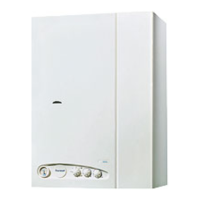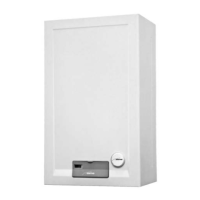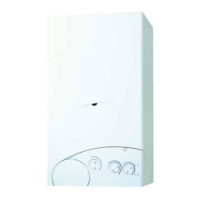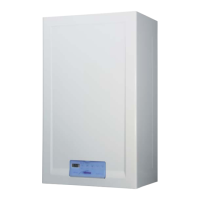8.19 C.H. EXPANSION VESSEL
In the unlikely event of failure of the expansion vessel diaph-
ragm it is acceptable to leave the vessel in position and to fit
a replacement vessel (of similar or greater capacity) external
to the appliance but as close as possible to the C.H. return.
Alternatively the vessel can be replaced as follows. Note
replacement is not recommended if a rear flue outlet is used
or if the clearance above the casing is less than 300 mm.
– Remove the outer casing as described in section 5.1.
– Isolate the C.H. flow and return valves (21 fig. 2), and
drain the appliance through the drain plug situated
below the pump
– Unscrew the expansion vessel pipe union at it’s connec-
tion with the D.H.W. heat exchanger.
– Remove the screw securing the expansion vessel bracket
at the top, rear of the appliance.
– If a rear flue outlet is used it is necessary to disengage
the flue and air duct temporarily. Refer to section 3.5.
– Remove the adjusting screws (5 fig. 7) on the wall
mounting bracket thereby allowing the appliance to
move slightly forwards at the top.
– Lift the expansion vessel, bracket, and pipe out of the
appliance through the top.
– Transfer the bracket and pipe to the new expansion ves-
sel, and re-assemble in reverse order. Re-pressurise and
re-commission the system as described in section 4.1.
8.20 SUMMER/WINTER SWITCH AND
CLOCK OVER-RIDE SWITCH
– Remove the outer casing as described in section 5.1.
– Remove the two screws TCB M4 x 10 (2 fig. 14) and
pivot the control box downwards, then remove the two
self tapping screws (1 fig. 14) and remove the control
box cover.
– Squeeze the switch to depress the retaining clips, then
withdraw the switch forwards.
– Pull off the connections to the switch.
– Fit the new switch and reassemble in reverse order, with
reference to the wiring diagrams in section 7.
8.21 PRESSURE GAUGE
– Remove the outer casing as described in section 5.1.
– Remove the two screws TCB M4 x 10 (2 fig. 14) and
pivot the control box downwards.
– Isolate the C.H. flow and return valves (21 fig. 2).
– Drain the appliance through the drain point situated
below the pump.
– Unscrew the pressure sensor from the top of the safety
valve.
– Squeeze the gauge to depress the retaining clips, then
ease the gauge forwards.
– Reassemble in reverse order. Refil and recommission the
system as described in section 4.1
8.22 SAFETY VALVE
– Remove the outer casing as described in section 5.1.
– Remove the two screws TCB M4 x 10 (2 fig. 14) and
pivot the control box downwards.
– Isolate the C.H. flow and return valves (21 fig. 2).
– Drain the appliance through the drain point situated
below the pump.
– Unscrew the pressure sensor from the top of the safety
valve.
– Unscrew the union supporting the outlet pipe from the
valve, and remove the valve by unscrewing it from the
main pipe connection.
– Fit the new safety valve using a suitable jointing com-
pound and reassemble in reverse order. Refil and recom-
mission the system as described in section 4.1
8.23 AUTOMATIC AIR VENT
– Remove the outer casing front panel as described in sec-
tion 5.1.
– Refer to fig. 8.
Remove the casing R.H. side panel by unscrewing the
two fixing screws.
– Isolate the C.H. flow and return valves (21 fig. 2).
– Drain the appliance through the drain point situated
below the pump.
– Unscrew the automatic air vent.
– Fit the new automatic air vent using a suitable jointing
compound and reassemble in reverse order. Refil and
recommission the system as described in section 4.1.
8.24 VIEWING WINDOW
– Remove the outer casing and sealed chamber front
panel as described in section 5.1.
– Unscrew the three screws and nuts securing the viewing
window.
– Replace the viewing window and gaskets, and reassem-
ble in reverse order.
8.25 TIME CLOCK
– Remove the outer casing as described in section 5.1.
– Remove the two screws TCB M4 x 10 (2 fig. 14) and
pivot the control box downwards, then remove the two
self tapping screws (1 fig. 14) and remove the control
box cover.
–
Pull off the electrical connections at the back of the clock.
– Remove the four screws securing the plastic frame of
the time clock to the facia panel.
– Remove the plastic frame and pull out the time clock.
– Re-assemble in reverse order and test the operation of
the new clock.
Set it to the desired settings.
29

